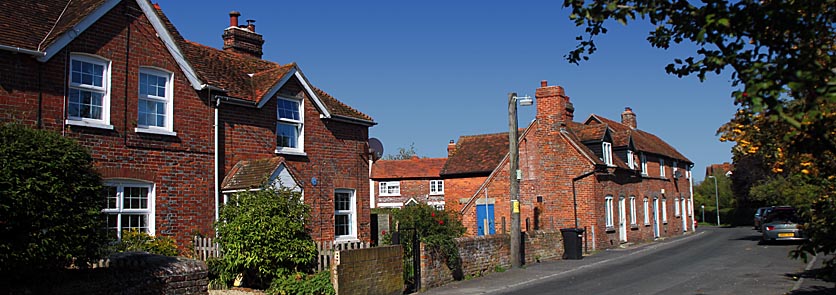 |
 |
|||
|
|
Compton for chasing Danes & Deer
There was a sizable community settled in Compton parish as far back as the Bronze Age when banks and ditches were constructed around a settlement which, in the Iron Age, was turned into the hillfort of Perborough Castle. The inhabitants farmed the surrounding area quite intensively and a large number of field systems have been examined on nearby Cow Down. In Roman times, a village, or perhaps a villa and associated farming community, was established in The Slad. It may be remembered in a field called 'Elbury' or 'Old Borough'. Many Roman finds have been discovered over the years: bricks, tiles, bones, pottery, a quern, a writing stylus and mosaic tesserae, as well as a phenomenal number of Roman coins. The 4th century inhabitants of this settlement may have been those found buried within a rectangular banked enclosure on Roden Down, north of the village. It was first a place of cremation, but ten became a family burial plot, the head of the household even having an expensive lead coffin. In the 6th century, Saxons settled where the present village stands and named it 'Compton' which means 'Comb-Town' or 'Valley Settlement'. Three centuries later, the area was at the centre of the fighting with the invading Danish Vikings. King Alfred's great victory over them at the Battle of Ashdown is said to have taken place around a solitary thorn tree; and 'Nachededorne' or 'Naked Thorn' was the old name for the Compton Hundred and possibly Compton itself. It is still remembered by Thorn Down and there is still an Ashdown Bottom in the parish. While Dennisford (Danes' Ford) alias Denispear (Dane's Spear) Road is supposed to have been that along which the Vikings fled after the battle. In Medieval times, Compton was divided into three manors: West Compton (the present village), East Compton (around the church) and Ashden. East Compton, owned by the Abbey of Wherwell in Hampshire, was originally a large village and was known as Compton Magna (or Great Compton). Few houses remain there today, however, as its population gradually deserted the place; possibly due to the Black Death (1349), the emparking of land or an increase in sheep farming which was more profitable and less labour intensive than growing crops. Signs of the 'Deserted Medieval Village' can be made out west of the parish church. West Compton was known as Compton Parva (or Little Compton) and was owned by the Norreys family from Yattendon. During the Civil War, the High Constable of Reading called a meeting together on Compton Downs at which he protested against the burdens placed upon the local people, but was gaoled for his trouble! After the Siege of Reading, in May 1644, the King's Army quit the town and regrouped on the Downs near Compton. The troops spent the night there while Charles I dined in the village. The following October, Prince Maurice and his troops retreated to Wallingford, via the village, after the Second Battle of Newbury. The next month, the parliamentary army camped here before moving on to Blewbury. Roden House (alias Stokes Manor) dates back to 1664,
but now has a fine Queen Anne frontage. The associated tithe barn is
said to have been built of ships' timbers. It was in the snowy Winter of
1779 that King George III
apparently caught up with a magnificent deer in the hall of this house,
where it was found admiring itself in a mirror! The Royal staghounds had
chased the beast all the way from Windsor
Forest, but how it managed to gain entry is unclear. The owner was
allowed to retain the hounds until the King returned on another day,
amongst great pomp and ceremony, to collect them. The deer was released
once more and only finally captured at Hurley.
King George gave the creature its liberty in his park and called it
'Compton'!
In the early 19th century, a witch lived in Compton
who was apparently able to stop horses in their tracks until she decided
to release them. It was at this time that the village had its own
windmill. It was a post mill, dated 1742, which had been transported
there from Little |
|||
| © Nash Ford Publishing 2003. All Rights Reserved. | ||||



